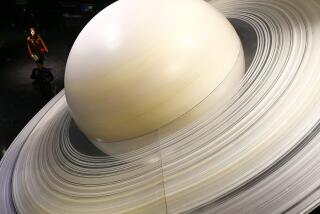Newly discovered ‘baby’ planets could unlock mysteries of planetary evolution
Astronomers scanning the sky for distant worlds have discovered two of the youngest exoplanets ever found. The two worlds, born around separate stars, are each just a few million years old – mere infants compared to the planets in our roughly 4.6-billion-year-old solar system.
The findings, described in two papers by different teams in the journal Nature, could offer some insight into the development of gas giants such as “hot Jupiters” and the evolution of their planetary systems.
The younger of the two planets orbits a star named V830 Tau, which sits some 430 light-years away. This star is young – scientists think it might be just 2 million years old. The planet, discovered using three ground-based telescopes, circles it in just 4.9 days. The scientists think it holds about 77% of the mass of Jupiter.
See the most-read stories in Science this hour »
The second planet, K2-33b, takes 5.4 days to circle its star, which sits in the “Upper Scorpius” region of the sky. While they don’t know its mass, it appears to be 5.8 times as wide as Earth (larger than Neptune, which is about 3.9 times as wide as Earth). Scientists think this planet, identified using NASA’s Kepler space telescope, might be somewhere around 5 to 10 million years old – probably older than the one around V830 Tau, but still so exceedingly young that its reddish star, K2-33, doesn’t seem to have fully contracted into its proper “adult” size yet.
Planets form out of the disk of dust and gas that surrounds nascent stars, eventually coalescing into rocky bodies, gas giants, comets, asteroids and other denizens of the void. And just as there are many different types of stars, there seem to be a wide variety of worlds that don’t feature in our own solar system, from super-Earths to mini-Neptunes.
One type in particular, the hot Jupiter, has baffled researchers because they sit so close to their host stars’ surfaces even though it’s unclear how they could have formed there. Scientists think that these planets must have formed farther out and then been somehow pulled in. After all, our four enormous, gassy planets – Jupiter, Saturn, Uranus and Neptune – are chilly, formed well away from the sun; it’s the small, rocky planets, including Earth, that sit closer in.
“These planets presumably form in the outer part of the primordial disk from which both the central star and surrounding planets are born, then migrate inward and yet avoid falling into their host star,” the authors of the V830 Tau study wrote. “It is, however, unclear whether this occurs early in the lives of hot Jupiters, when they are still embedded within protoplanetary disks, or later, once multiple planets are formed and interact.”
A star in its infancy, however, can help answer these questions. Because V830 Tau is so young, for example, the researchers think its in-close gas giant may have migrated from farther out when the protoplanetary disk was largely still in place.
K2-33b will also provide some insight into the evolution of these planets and their systems, said Caltech astronomer Lynne Hillenbrand, one of the authors of the second paper. Previous research had found evidence that K2-33 still had a few remaining shreds of its protoplanetary disk – which means it’s being observed in the last stages of an important, early chapter in its developmental history.
Hillenbrand said the next steps for K2-33b should include studying its atmosphere using NASA’s Hubble and Spitzer space telescopes. But before they can start to draw broader conclusions, they’ll have to find many more baby stars with their fledgling planets.
“I think if we can build up a sample and find more of these exciting objects, we’ll be able to tell a story,” she said, “but hopefully this is the tip of the iceberg and we’ll be finding more.”
Follow @aminawrite on Twitter for more science news and “like” Los Angeles Times Science & Health on Facebook.
MORE SCIENCE NEWS
To make chocolate healthier and tastier, all you need is an electric beam
Scientists turn plastic bottles and bags into liquid fuel
How running shoes change the muscles in your feet







